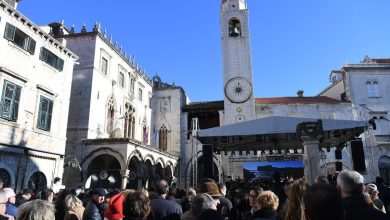At 8 pm tonight, Dubrovnik Museums’ central exhibition ‘Stjepan Gradić: Father of the Homeland’ will open at the Rector’s Palace marking the 400th anniversary of Gradic’s birth.
Dubrovnik Museums have in the last few months, organised a series of educational workshops for children of primary and secondary school age in order to get more acquainted with the life and creativity of this big character of Dubrovnik.
The exhibition was organised under the auspices of the President of the Croatian Parliament, Josip Leko, and sponsored by the City of Dubrovnik with the support of Croatian Ministry of Culture.
Gradić played an important role in the rebuilding and repair of Dubrovnik following the large earthquake in 1667 as explained by academic Stjepan Krasic, ”It was his plan was to first restore the Rector’s Palace and then the Cathedral. After their restoration, the renovation of the entire city followed, so thanks to Gradić Dubrovnik has the appearance it has today.”
The exhibition will run until October 15th. For more information on Dubrovnik Museums, visit the website here.
About Stjepan Gradić
Stjepan Gradić (Dubrovnik, 1613 – Rome, 1683) was educated in Dubrovnik, Rome, Fermo and Bologna. There he gained an impressive training in philosophy, theology, canon and civil law, mathematics and classical and modern languages. It is not to be wondered at that he had a brilliant career in Rome, one of the greatest historical, cultural, religious, political and scientific centres of its time in Europe. He was a member of several dicasteria or ministries of the Holy See; he was director of the prestigious Vatican Library, only the third non-Italian to have held that position; he was an expert in international relations and a champion of European unity in spite of all the differences among the individual states; above all, he was a man of learning. He successfully dealt in theology, philosophy, law, history, mathematics, physics, meteorology and other scientific disciplines. He carried out experiments relating to the practical application of theoretical advances in optics, navigation, shipping and hydromechanics, and in connection with this kept up links with scholars and scientists throughout Europe. His oeuvre included about a hundred books, treatises and articles.
What particularly characterised Gradić the man was his great patriotism, which came particularly to the fore after the great earthquake of 1667 that practically razed the whole of his native city to the ground. From the first tidings of the catastrophe to the last breath he took, his love for his homeland was reflected in the selfless work of assisting his afflicted homeland in all forms: providing and finding money, food, care for the homeless, building materials, artisans of all kinds, and architects as well, so that the city should be raised as soon as possible from its ruins and defended from the external foe. He insisted that first of all the dwelling places, the family houses, should be built, and then the Rector’s Place, the administrative centre of the town and the cathedral, focus of civilisation and the religious life. For this he engaged from abroad excellent architects and made available considerable sums of money. Thanks to all his efforts, the city rose like the legendary Phoenix, little by little arising from the piles of stones and ashes and taking on the form that all wonder at today. For all this, his contemporaries bestowed on Gradić the most honourable titles that the citizen of a town or country may be named: “father of the homeland” and “reviver of our city and our liberty”. All of these are more than reason enough for his character and works never to be forgotten.



